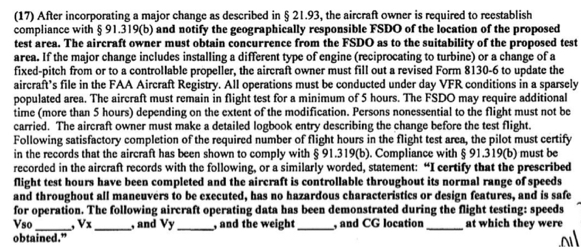Ed_Wischmeyer
Well Known Member
So there's lotsa stuff out there for a complete flight test program, but I'm not sure I've seen anything for a five hour Phase 1 like I'll do when I get the constant speed prop on.
The current "plan:"
* First flight is one hour near the airport, then land and check for leaks. (Yes, there will be a thorough leak check before I take off). Also check max RPM is achievable and the governor won't overspeed the prop;
* Test flight for Vx, Vy, and Vso. That should be easy as the very helpful Atlanta FSDO does not require max gross weight, only that I record gross weight and c.g. as flown. Plus, with an autopilot and digital flight data recorder on the Garmin G3X touch, I can put the autopilot in airspeed hold and should get high repeatability;
* Takeoffs and landings:
- takeoffs with different initial climb speeds (65-75 knots);
- landings with different speeds entering the flare to see how long it floats. With the fixed pitch prop, each 5 knots is worth maybe 3 seconds longer float, and that's a factor in crosswind landing speeds;
- power off traffic patterns at 60, 65, ... 80 kt, to see what those are like for short approaches;
* Cruise at 8,000 ft, plus or minus, and see what I get using 8 GPH as my de facto power setting, and the new prop does not have the 2600 RPM limit that the old one did. Eight GPH makes fuel calculations lots simpler;
* Airspeed calibration, since that was apparently not done by the original builders, and that should be easy. Instead of doing a four course airspeed profile, I can fly directly upwind and downwind. And I can let the autopilot do that in a holding pattern.
Not part of the five hours but something I'll do later on is look at how fast I can fly an ILS and when I'd need to pull the power back. The other day I did one at max speed, per ATC request, turned out to be 150 kt, and I hit one little bump that gave me 3 Gs.
That seems like a good list to me, but I've got to believe that group wisdom will point out something I've overlooked... Comments?
The current "plan:"
* First flight is one hour near the airport, then land and check for leaks. (Yes, there will be a thorough leak check before I take off). Also check max RPM is achievable and the governor won't overspeed the prop;
* Test flight for Vx, Vy, and Vso. That should be easy as the very helpful Atlanta FSDO does not require max gross weight, only that I record gross weight and c.g. as flown. Plus, with an autopilot and digital flight data recorder on the Garmin G3X touch, I can put the autopilot in airspeed hold and should get high repeatability;
* Takeoffs and landings:
- takeoffs with different initial climb speeds (65-75 knots);
- landings with different speeds entering the flare to see how long it floats. With the fixed pitch prop, each 5 knots is worth maybe 3 seconds longer float, and that's a factor in crosswind landing speeds;
- power off traffic patterns at 60, 65, ... 80 kt, to see what those are like for short approaches;
* Cruise at 8,000 ft, plus or minus, and see what I get using 8 GPH as my de facto power setting, and the new prop does not have the 2600 RPM limit that the old one did. Eight GPH makes fuel calculations lots simpler;
* Airspeed calibration, since that was apparently not done by the original builders, and that should be easy. Instead of doing a four course airspeed profile, I can fly directly upwind and downwind. And I can let the autopilot do that in a holding pattern.
Not part of the five hours but something I'll do later on is look at how fast I can fly an ILS and when I'd need to pull the power back. The other day I did one at max speed, per ATC request, turned out to be 150 kt, and I hit one little bump that gave me 3 Gs.
That seems like a good list to me, but I've got to believe that group wisdom will point out something I've overlooked... Comments?





